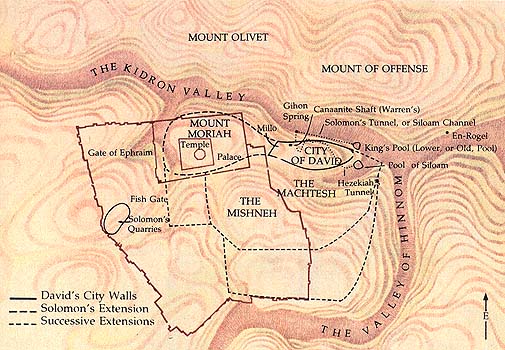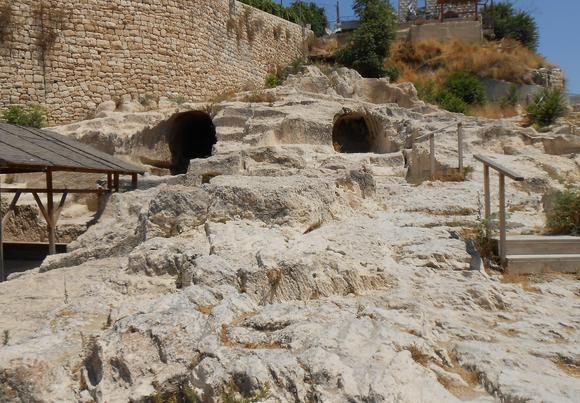Re: David’s tomb:
We know from the Old Testament that David was buried in
Ir David, the City of David: “Then David slept with his fathers and was buried in the city of David.” (1 Kings 2:1) This citadel was located on the lower part of ancient Jerusalem’s Eastern Hill, which, as the name implies, is on the eastern part of Jerusalem. The Temple Mount (aka Mount Moriah) is actually the highest part of this hill. (To put things in context, the Upper Room/‘David’s Tomb’ is on the
Western Hill, on the opposite side of the city - which in David’s time wasn’t even a part of Jerusalem yet.)

In 1913, French archaeologist Raymond Weill found around nine man-made burial caves on the southern tip of
Ir David (labelled T1 to T9), among them three horizontal gallery graves. Weill believed that he had found what was the royal cemetery of Jerusalem, an identification many modern archaeologists today still share (though this has recently come under question); he also identified T1, the most monumental of the tombs, as that of David.

Two of the caves Weill discovered (T1 and T2).
The original location of David’s tomb was apparently well-known; during the 5th century BC, Nehemiah refers to “the tombs of David” in his description of the rebuilding of the walls of Jerusalem when the exiles returned from Babylon in the late 6th century BC (Nehemiah 3:16).
We might infer that the location of the tomb - or a site that was claimed to be the location of the tomb - was still known just before and during the time of Jesus. The Jewish historian Josephus (
Antiquities 7.393; 16.179-183) claimed that around three thousand talents of silver buried with David in his tomb was looted by the high priest John Hyrcanus (reigned 134-104 BC) to pay Seleucid king Antiochus VII Sidetes in exchange for lifting his siege on Jerusalem. Later, he claims that Herod the Great once clandestinely tried to loot the tomb as well; however, when two of Herod’s guards met a mysterious death, fear overcame him and he ordered a tomb-memorial (
mnēna) of white stone erected at the site. This monument erected by Herod was probably what Peter was referring to in Acts 2:29 when he says that “David’s tomb/monument (
mnēna) is with us to this day.”
The last person we know of who knew the location of David’s tomb was the 1st-2nd century Jewish rabbi Akiva. Akiva was once asked why the graves of the Davidic dynasty were allowed within the city (remember, as I noted earlier, it became customary for Jews to build tombs outside the city walls). He responded that impurity of David’s grave was diverted out of the city to the Kidron Valley via a rock channel. This information is important because the Kidron lies on the east side of Ir David. It clearly indicates that Akiva placed the royal tombs on the Eastern Hill close to the Kidron.
So, how did David’s tomb end up being in the Upper Room?
Knowledge of the real location of David’s tomb was lost when Jerusalem was destroyed by the Romans and the Jews kicked out of the city. When the Jews were banned from entering Jerusalem (except for one day every year), the location of David’s tomb went along with them. So, from about the 2nd century up to the 11th-12th century, the Jews venerated David’s tomb in his native Bethlehem, an identification Christians also came to accept. After all, doesn’t the gospel of Luke call Bethlehem “the city of David” (the same term that was applied in the OT to ancient Jerusalem)? As a result, Christian pilgrims in Late Antiquity and the early Middle Ages who visited the Holy Land all reported seeing the purported tomb of David in Bethlehem rather than in Jerusalem.
Then, when the Crusaders came along, they again shifted the location of David’s tomb back to Jerusalem; they began to claim that it was actually under the Cenacle, aka Upper Room. (The Cenacle was an ancient Christian site; we don’t know if it is the actual upper room Jesus held the Last Supper in, but some archaeologists do believe that it was the site of a synagogue/house church used by the Jewish Christian community in Jerusalem.) We don’t know exactly what caused the Crusaders to identify David’s tomb as being in the Cenacle. Maybe it was done out of convenience; I mean, the Bible
does say David was buried in Jerusalem, so they needed to find a location for it. And the Upper Room is an important church, so hey, why not place David’s tomb there?
Soon, the Jews themselves also began to accept this identification, and the rest is history.


